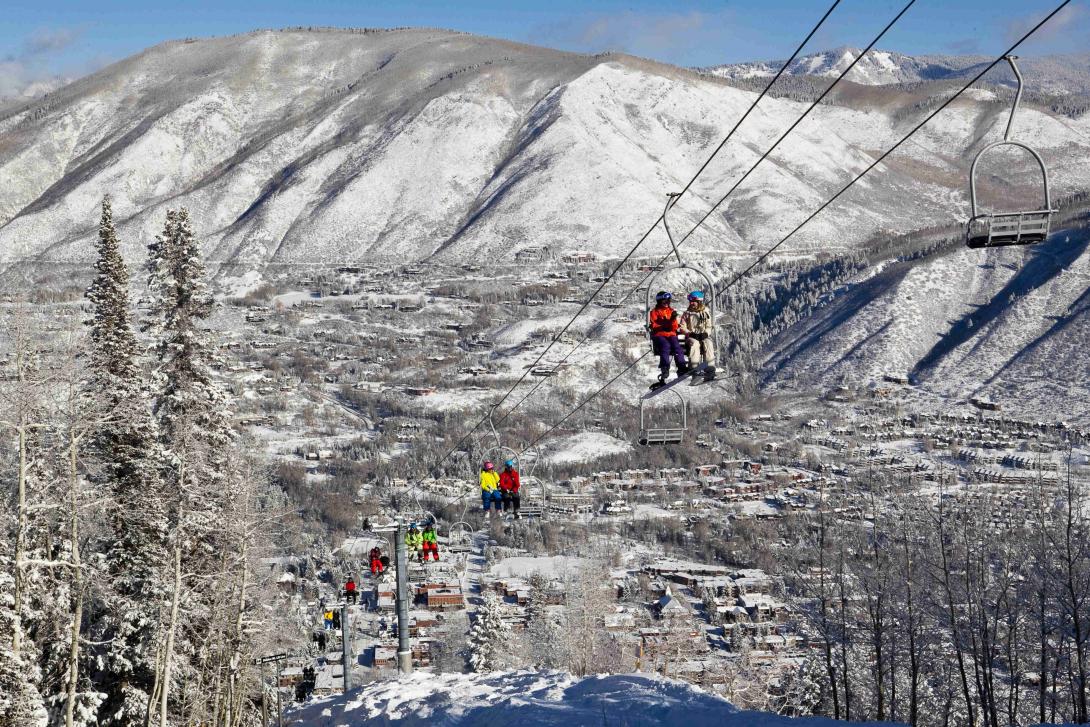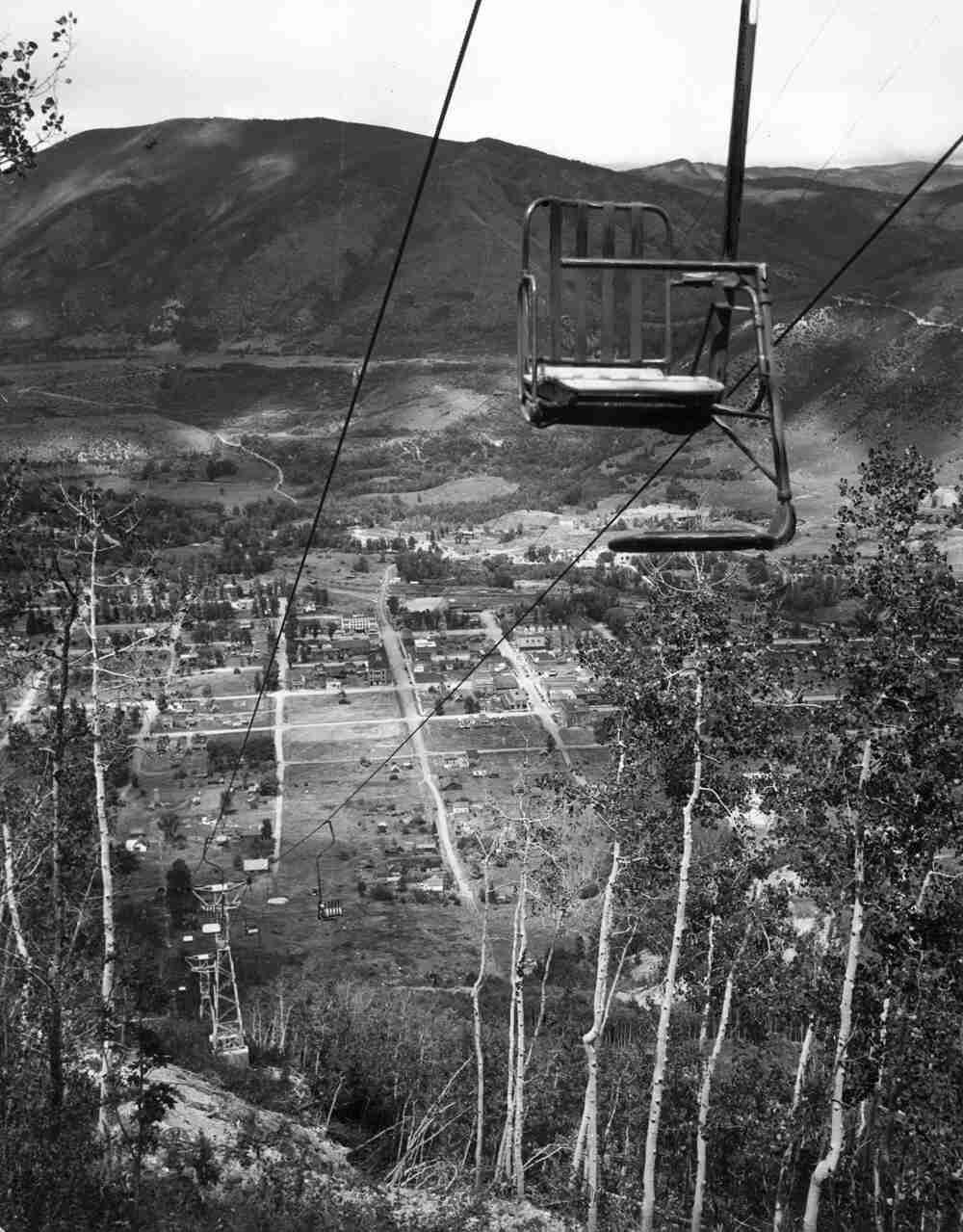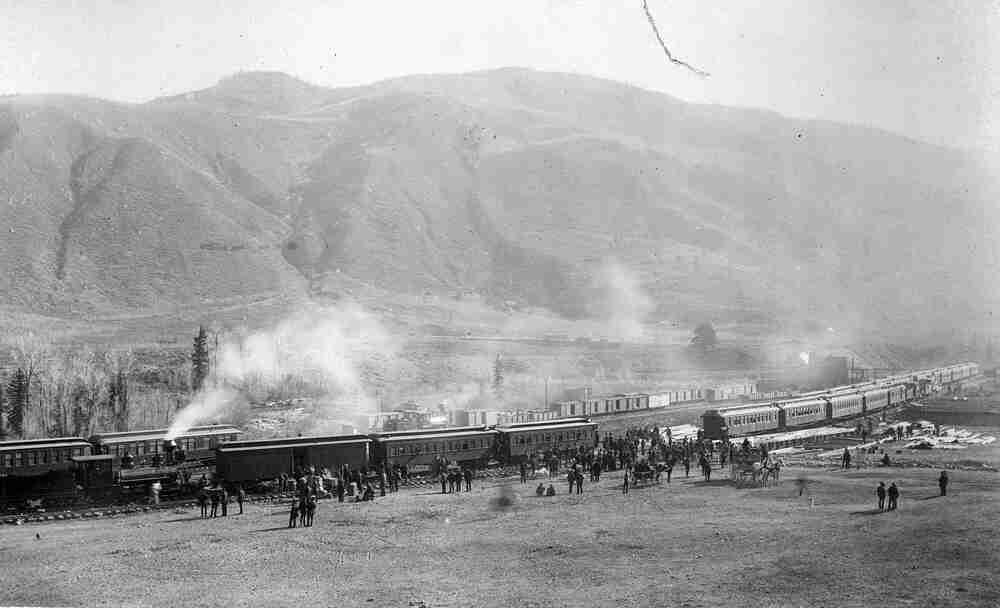Aspen
Full Article
Aspen, located along the Roaring Fork River west of Independence Pass, is the county seat of Pitkin County. Now one of the state’s most iconic hubs for culture and recreation, Aspen began like many Colorado towns—as a small mining camp, founded by Henry B. Gillespie in 1879. Rich silver mines in the nearby Elk and Sawatch Mountains made the town one of the most prosperous mining centers on Colorado’s Western Slope until an 1893 crash in silver prices nearly rendered it a ghost town. Aspen survived and eventually became a renowned center for the arts and culture, as well as a world-class ski destination. As of 2013, Aspen had a population of nearly 7,000. It continues to draw not only thousands of visitors from Colorado and the United States but also celebrities and tourists from all over the world.
Early History
The Roaring Fork valley is the ancestral home of the Ute people, who used it as summer hunting grounds. During the 1870s, a mining boom drew thousands of white settlers to Colorado’s Western Slope, resulting in clashes between whites and Utes. These conflicts grew to a fever pitch in the late 1870s, especially after Colorado was granted statehood in 1876. In 1880 the US government forcibly relocated the Ute population in western Colorado to a reservation in eastern Utah, allowing for the expansion of white mining and settlement.
In the fall of 1878, the Hayden Geological Survey published a report that noted the presence of promising geologic formations, possibly containing silver and other precious minerals, in the Roaring Fork valley. Prospectors who caught wind of the Hayden report braved treacherous mountain passes to explore the valley for silver and to stake claims on what would eventually prove to be one of the richest silver lodes in history. As one of the earliest American arrivals to the valley, Henry B. Gillespie established the first permanent mining camp along the Roaring Fork in 1879. He named it Ute City.
Mining Boom and Bust
Even though Gillespie petitioned federal officials in Washington, DC, for a post office, growth was slower than he had anticipated. However, on July 4, 1879, prospectors discovered the Independence Gold Lode not far from Ute City, and miners flooded into the valley. In 1880 B. Clark Wheeler and Charles A. Hallam, agents and co-partners of Cincinnati businessman David Hyman, arrived in Ute City. The two men purchased several mining claims on Aspen Mountain, and Wheeler quickly surveyed the Ute City town site, renaming it Aspen. The first newspaper, Wheeler’s Aspen Times, began publishing in 1881. Jerome B. Wheeler, half-owner of Macy’s Department Stores, arrived in 1883 and made considerable investments in Aspen mines and buildings. In 1888–89 he built two of the most famous landmarks in Aspen, the Hotel Jerome and the Wheeler Opera House.
Shipping ore from such a remote site proved difficult in Aspen’s early years. In 1881 the Taylor Pass route opened as the only east-west route into Aspen that could accommodate wagons. Without a reliable route to the Leadville smelters, Aspen mines were unable to ship ore by wagon train. By 1882, several stage lines began operations, running passengers and limited quantities of ore from Aspen to Leadville, but even these improved roadways were slow, costly, and dangerous. Finally, in 1887 the Denver & Rio Grande Railroad reached Aspen, allowing the mines to efficiently ship ore.
A second railroad, the Colorado Midland, made it to Aspen by 1888. Then, in 1890 Congress passed the Sherman Silver Purchase Act—which increased the amount of silver the US government was required to buy each month—and the town saw spectacular growth. By 1891, Aspen hosted a population of more than 5,000 and surpassed Leadville as the largest silver-producing district in the United States. It boasted one-sixth of the US total and one-sixteenth of the world’s total silver production.
However, just two years later, a global economic crisis touched off the Silver Panic of 1893. The federal government repealed the Sherman Act that fall, officially demonetizing silver and ruining many silver mining towns across the West. The Aspen economy was devastated by the 1893 Silver Panic, but like many of Colorado’s other mining towns, it would survive and be reimagined around a relatively new winter sport gaining popularity in the United States.
Ski Boom
In the nineteenth century, many years before skiing became a popular pastime, European immigrants introduced western miners to skis. Residents of mountain mining towns had to use skis—then called Norwegian Snow Shoes—to get around during long winters. In the winter months, deep snow in the Roaring Fork valley made it nearly impossible to travel without skis, and Aspen residents often relied on skiers to carry messages and supplies to and from the town. After the 1893 silver crash, skiing persisted in Aspen. In December 1936, the Highland Bavarian Lodge and a six-passenger boat tow, powered by an old mine hoist and truck engine, were built at the base of Aspen Mountain. On the day after Christmas in 1936, Aspen’s first ski lodge opened its doors to the public.
By 1941, the Winter Sports Club (later known as the Aspen Valley Ski Club) was hosting national downhill and slalom events, garnering the town international attention. After the United States’ entrance into World War II, the Tenth Mountain Division was formed and stationed at Camp Hale near Leadville. Using facilities on Aspen Mountain, the Tenth Mountain Division trained in Aspen during the war, eventually seeing action in Italy. After the war, many of the soldiers returned to the Roaring Fork valley and other mountain areas to help develop skiing. Meanwhile, wartime surpluses in cold weather equipment, growing incomes among middle-class Americans, and postwar developments in mechanical engineering made skiing more popular and accessible. It did not take long for companies such as the Aspen Skiing Corporation to form and to seize the opportunity to reimagine destitute mining towns as sites for outdoor recreation.
Wealthy Chicago businessman Walter Paepcke and his wife Elizabeth came to Aspen in the late 1930s and again after the war. Along with partner Friedl Pfeifer, the Paepckes started the Aspen Skiing Corporation, which opened the area’s first mechanical chairlift in December 1946. At the time, it was the longest in the world. The new chairlift attracted thousands of new skiers to Aspen every year, setting a precedent for the Colorado ski industry. In 1946, to complement the well-established overland routes into Aspen, a rough gravel airstrip—Sardy Field—was built, and by 1948 commercial flights were able to reach Aspen with relative ease. In 1958 a second and third ski resort, Buttermilk and Aspen Highlands, opened up for business.
Aspen Institute
As longtime patrons and sponsors of the arts and cultural organizations, the Paepckes also saw the potential for scenic Aspen to be a hub for intellectuals and the arts. In 1949 Walter Paepcke made Aspen the site of the 200th anniversary celebration of the German poet Johann Wolfgang von Goethe, an event that attracted intellectuals from all over the world. The success of that event prompted Paepcke, a trustee of the University of Chicago, to establish the Aspen Institute. Its first seminar, the Executive Seminar, brought business leaders together to discuss the work and impact of the world’s greatest writers. Later, the institute evolved to incorporate the arts as well, developing both the Aspen Music Festival and the International Design Conference. Today, the institute’s mission continues to be the fostering of leadership based on enduring values, and to provide a nonpartisan venue for dealing with critical national and international issues. The institute maintains a campus in Aspen, linking the small mountain town to a network of global leaders, artists, thinkers, and musicians. The Paepckes were instrumental not only in the town’s economic shift from mining to skiing, but also in Aspen’s growth into the cultural hub of Colorado’s Western Slope.
Today
Today, Aspen has a population of nearly 7,000 and four world-class ski resorts. Despite decades of attempts by local officials to maintain affordable housing, in 2011 Aspen ranked as the most expensive town in the United States. In 2015 Forbes named Aspen as the ninth-most expensive ZIP code in the United States, with a median property value of more than $5 million. Since 2002, it has hosted the Winter X Games, an annual winter sports contest that attracts thousands of visitors from around the world. Tourists also come to Aspen to see the Maroon Bells, dramatic twin peaks located southwest of town. Maroon Lake, at the foot of the 14,000-foot peaks, is the most photographed landscape in the state, drawing more than 300,000 visitors each year.
Due in part to its beauty and international renown for world-class skiing, Aspen has become a recreation destination for the country’s elite. With celebrity regulars from Mariah Carey to Lance Armstrong, Aspen has come to be recognized as a place where the world’s wealthiest and most well-known men and women come to play and spend. Increasingly, wealthy men and women are putting down roots in Aspen, creating a city that in many ways resembles downtown Manhattan more than the small mining camp it was in 1879.
Anna Scott of the Aspen Historical Society assisted with this article.





